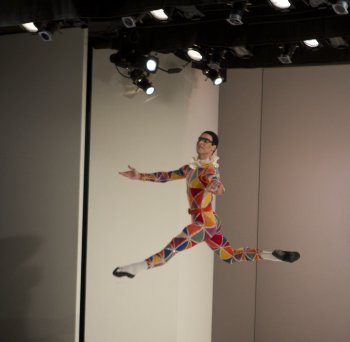Balanchine’s Harlequinade: Commedia dell’arte Explored
An entertaining discourse on Commedia dell’arte, George Balanchine and Marius Petipa.

Angelica Generosa and Kyle Davis in a scene from Petipa’s “Les Millions d’Arlequin” (Photo credit: Works & Process at the Guggenheim/Jacklyn Meduga)
[avatar user=”Joel Benjamin” size=”96″ align=”left” ] Joel Benjamin, Critic[/avatar] The prestigious Works & Process series at the Solomon R. Guggenheim Museum began this season with a fascinating and lucid examination of George Balanchine’s Harlequinade (1965), comparing it to the 1900 Marius Petipa ballet Les Millions d’Arlequin, and relating the two ballets to the tradition of Commedia dell’Arte. Both the Balanchine and Petipa ballets used the same bubbly score by Riccardo Drigo and both were explorations of Commedia stock characters. How the two works differed and how they each treated their characters was the gist of this program.
Dance historian Doug Fullington of the Pacific Northwest Ballet was the expert who, using slides and excerpts from both the Balanchine and Petipa versions, showed how each choreographer envisioned the interactions of such Commedia stalwart characters as Harlequin, Colombine, Pierrot, Pierrette, the Doctor and Pantalone, each with their own idiosyncratic personality quirks and historically recognizable costumes. Commedia dell’Arte has had enormous influence on painters (Watteau, Picasso), theater and even films (Chaplin, the Marx Brothers) with its pratfalls and slapstick and colorful personalities.
Before the six participating dancers displayed impeccable technique, Mr. Fullington took us back to Italy in the 16th century via slides of paintings. He told of how itinerant performers joined together and formalized these different characters. Commedia dell’Arte was an unscripted, improvised form. Its characters traveled to other countries, particularly France, changing and codifying along the way.
By the time Petipa choreographed his successful Les Millions d’Arlequin, Commedia, itself, wasn’t performed, but its characters had taken on mythological importance. George Balanchine danced in the Petipa ballet as a young dance student and it was his fond memories of the work that informed his Harlequinade.
Mr. Fullington resuscitated the Petipa choreography from detailed notes taken during the early 20th century, most in Stepanov notation which was detailed in its depiction of the relationship of the ballet steps to music and the intention of each step. The Balanchine is still performed by the City Ballet.
Two dancers from the Pacific Northwest Ballet, Kyle Davis and Angelica Generosa in practice clothes, performed all the Petipa choreography while NYCB stars Gonzalo Garcia, Anthony Huxley, Tiler Peck and corps de ballet member Claire Von Enck did the honors for the Balanchine version, in the vivid original costumes.

Gonzalo Garcia in a scene from Balanchine’s “Harlequinade” (Photo credit: Works & Process at the Guggenheim/Jacklyn Meduga)
What was most remarkable was that the Petipa choreography was just as musical and brilliantly character driven as the Balanchine. Both knew how to tell stories with the subtlest of gestures and both were extremely musically savvy.
For example, in Balanchine’s version of Colombine’s variation, “Berceuse,” Tiler Peck floated about on point, her arms softly undulating while in Petipa’s version, Ms. Generosa’s hands fluttered softly over quick steps onto point. Similarly, in Petipa’s variation for Harlequin, Mr. Davis performed a series of jumps in which his legs formed diamond shapes in the air, while Balanchine’s version was punctuated by virtuoso beats, joyously performed by Mr. Garcia. Both choreographers caught the devil may care insouciance of this character.
Balanchine dropped a good deal of Petipa’s libretto with its old-fashioned flirtations and intrigues, yet succeeded in creating vivid characters. Mr. B’s “Grand pas des Alouettes,” a Pas de Deux, ended the program, danced beautifully by Mr. Garcia and Ms. Peck. In its steps it was possible to see how the greatest classical ballet choreographer of the 20th century honored his 19th century counterpart, and the ballet he had danced more than fifty years before. Petipa was an indelible influence on Balanchine’s work. This was a gracious dance of infatuation with intricately musical partnering, few lifts and many loving glances, a still fresh take on the ancient Commedia characters.
Cameron Grant, solo pianist of the New York City Ballet, provided expert accompaniment for all the ballet excerpts. This is a musician who understands the nuances of ballet music and the needs of dancers.
One thing is sure. No one attending this Works & Process program will ever watch Balanchine’s Harlequinade in the same way they did before.
Balanchine’s Harlequinade: Commedia dell’arte Explored (September 20 and 21, 2015)
Works & Process
Peter B. Lewis Theater at the Solomon R. Guggenheim Museum, 1071 Fifth Avenue, in Manhattan
For tickets call 212-423-3575 or visit http://www.guggenheim.org
Running time: one hour and 15 minutes with no intermission






Leave a comment